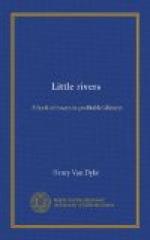The Ristigouche is a noble stream, stately and swift and strong. It rises among the dense forests in the northern part of New Brunswick—a moist upland region, of never-failing springs and innumerous lakes—and pours a flood of clear, cold water one hundred and fifty miles northward and eastward through the hills into the head of the Bay of Chaleurs. There are no falls in its course, but rapids everywhere. It is steadfast but not impetuous, quick but not turbulent, resolute and eager in its desire to get to the sea, like the life of a man who has a purpose
“Too great for haste, too high for rivalry.”
The wonder is where all the water comes from. But the river is fed by more than six thousand square miles of territory. From both sides the little brooks come dashing in with their supply. At intervals a larger stream, reaching away back among the mountains like a hand with many fingers to gather
“The filtered tribute of the rough woodland,”
delivers its generous offering to the main current.
The names of the chief tributaries of the Ristigouche are curious. There is the headstrong Metapedia, and the crooked Upsalquitch, and the Patapedia, and the Quatawamkedgwick. These are words at which the tongue balks at first, but you soon grow used to them and learn to take anything of five syllables with a rush, as a hunter takes a five-barred gate, trusting to fortune that you will come down with the accent in the right place.
For six or seven miles above Metapedia the river has a breadth of about two hundred yards, and the valley slopes back rather gently to the mountains on either side. There is a good deal of cultivated land, and scattered farm-houses appear. The soil is excellent. But it is like a pearl cast before an obstinate, unfriendly climate. Late frosts prolong the winter. Early frosts curtail the summer. The only safe crops are grass, oats, and potatoes. And for half the year all the cattle must be housed and fed to keep them alive. This lends a melancholy aspect to agriculture. Most of the farmers look as if they had never seen better days. With few exceptions they are what a New Englander would call “slack-twisted and shiftless.” Their barns are pervious to the weather, and their fences fail to connect. Sleds and ploughs rust together beside the house, and chickens scratch up the front-door yard. In truth, the people have been somewhat demoralised by the conflicting claims of different occupations; hunting in the fall, lumbering in the winter and spring, and working for the American sportsmen in the brief angling season, are so much more attractive and offer so much larger returns of ready money, that the tedious toil of farming is neglected. But for all that, in the bright days of midsummer, these green fields sloping down to the water, and pastures high up among the trees on the hillsides, look pleasant from a distance, and give an inhabited air to the landscape.




